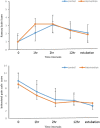Gabapentin as Add-On to Fentanyl and Midazolam in Patients Receiving Mechanical Ventilation: A Randomized, Blinded Study
- PMID: 35544248
- PMCID: PMC9361057
- DOI: 10.5152/TJAR.2022.21366
Gabapentin as Add-On to Fentanyl and Midazolam in Patients Receiving Mechanical Ventilation: A Randomized, Blinded Study
Abstract
Objective: Fentanyl and midazolam are popular drugs for sedation and analgesia in intensive care unit. Gabapentin has sedative and analgesic effects, as well. Our purpose was to study gabapentin addition to fentanyl and midazolam to reach the target sedation level in patients requiring mechanical ventilation.
Methods: This was a randomized and double-blinded trial. Fifty patients receiving mechanical ventilation and aged from 18 to 70 years were randomized 1 : 1 to 300 mg gabapentin q8hr or placebo. The initial infusion rates of fentanyl and midazolam were 1-2 µg kg-1 h-1 and 0.06-0.2 mg kg-1 h-1, respectively, in both groups. Treatments continued prior to weaning. Ramsay sedation scale score (2-3) and behavioral pain scale score (≤4) were used for the evaluation of sedation and analgesia levels, respectively.
Results: A total of 43 patients were studied. Both treatment modalities reached the target sedation and analgesia levels. In the intervention group, there were significant reductions in daily consumption of fentanyl and midazolam (P < .01). Duration of ventilation was shorter in the intervention group (4.1 ± 1.7 days vs 5.1 ± 1.3 days, P > .05). There was no significant difference in intensive care hospitalization, although it was shorter in the intervention group (201 ± 24 hours vs 224 ± 19 hours, P > .05).
Conclusions: This trail showed that both treatment modalities could reach target sedation and analgesia levels without significant differences. Add-on therapy with gabapentin could reduce the total dose of fentanyl and midazolam.
Figures
Similar articles
-
Decreased duration of mechanical ventilation when comparing analgesia-based sedation using remifentanil with standard hypnotic-based sedation for up to 10 days in intensive care unit patients: a randomised trial [ISRCTN47583497].Crit Care. 2005 Jun;9(3):R200-10. doi: 10.1186/cc3495. Epub 2005 Mar 15. Crit Care. 2005. PMID: 15987391 Free PMC article. Clinical Trial.
-
[A study of using dexmedetomidine in ventilator bundle treatment in an ICU].Zhonghua Wei Zhong Bing Ji Jiu Yi Xue. 2015 Oct;27(10):836-40. Zhonghua Wei Zhong Bing Ji Jiu Yi Xue. 2015. PMID: 27132448 Clinical Trial. Chinese.
-
Sedation during mechanical ventilation: a trial of benzodiazepine and opiate in combination.Crit Care Med. 2006 May;34(5):1395-401. doi: 10.1097/01.CCM.0000215454.50964.F8. Crit Care Med. 2006. PMID: 16540957 Clinical Trial.
-
Impact of Oral Clonidine on Duration of Opioid and Benzodiazepine Use in Mechanically Ventilated Children: A Randomized, Double-Blind, Placebo-Controlled Study.Iran J Pharm Res. 2019 Fall;18(4):2157-2162. doi: 10.22037/ijpr.2019.14862.12705. Iran J Pharm Res. 2019. PMID: 32184880 Free PMC article.
-
Analgesia and sedation during mechanical ventilation in neonates.Clin Ther. 2005 Jun;27(6):877-99. doi: 10.1016/j.clinthera.2005.06.019. Clin Ther. 2005. PMID: 16117990 Review.
Cited by
-
Adverse respiratory events during treatment with gabapentin and opioids among older adults with spine-related conditions: a propensity-matched cohort study in the US Medicare population.Spine J. 2025 Sep;25(9):2096-2107. doi: 10.1016/j.spinee.2025.03.014. Epub 2025 Mar 27. Spine J. 2025. PMID: 40157427
References
LinkOut - more resources
Full Text Sources


